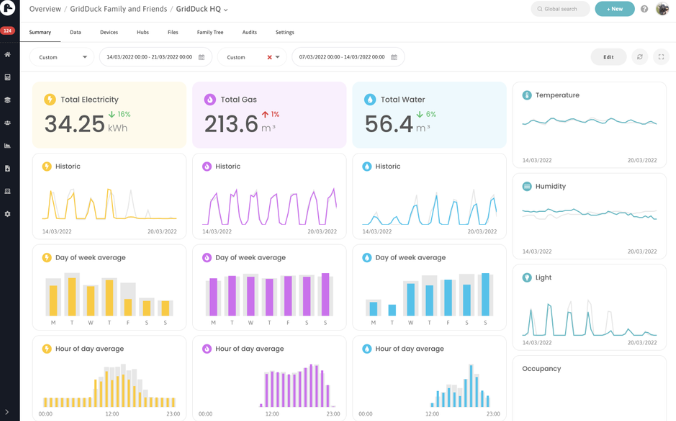GridDuck’s 2022 Energy Summary: Our Top Tips and Insights for Businesses
We recap on our content from 2022, targeted at businesses looking to become energy efficient, cut back on energy waste and save on emissions. It’s a year that will probably be most remembered for two interconnected things: inflation and soaring energy bills, leading to a crisis in the cost of living.
For businesses, rising energy costs can mean the difference between being able to keep trading, or throwing in the towel. Estimates vary but businesses recently renewing contracts might have to pay up to five times what they paid just two years ago.
In the last 12 months, GridDuck has worked with its business clients to reduce this burden, offering triple utility monitoring and making continual improvements to our energy monitoring system. Next year we will add custom fields for your KPIs. That way you can quickly see your energy consumption per hotel room, manufacturing plant, meal served or widget made.
As the year draws to a close, we look back at the GridDuck blog, offering one insight or tip we’ve learned for each month of the year.
January
We kicked off the year with predictions about the energy sector. Little did we know that we were a month away from the war in Ukraine, a development that compounded difficult energy conditions. One of our partners, Mike Davies from ClearCost Energy, predicted that it was going to be a rollercoaster for energy prices – and he wasn’t wrong.
Davies had a word of caution for businesses: “The combination of volatile energy prices and the introduction of net zero initiatives during 2022 leaves plenty of scope for organisations to get their energy contracting strategy badly wrong.”
Insight: Any energy contracting strategy should consider how costs can be contained during peaks in market prices and how to reap rewards when the price dips, including savings produced from net zero initiatives.
February
In February we discussed how triple utility monitoring – gas, water and electricity – can benefit businesses looking to make cost savings, in particular for those working in the hospitality industry. One survey of hospitality businesses found that 78% cited energy waste as a top irritation, while nearly half (45%) often switched off machines that are not in use.
With triple monitoring, you are able to break down your energy usage: which appliances and equipment are costing you the most money and what steps you need to take to become more energy efficient. What’s more, it can help you stay on top of maintenance issues and schedule routine checks.
In March, GridDuck announced all-in-one monitoring for customers after months of testing and software development.
Insight: As a business, total financial visibility of quarterly utility bills, investment payback and operational anomalies cannot be undervalued. Gas, water and electricity monitoring gives you all of the information required to make important decisions.
March
While GridDuck’s aim is to help businesses become more energy-efficient and save on bills, we also campaign for causes we believe in, including making the energy sector more inclusive and diverse. To that end, we interviewed Dhara Vyas, deputy director for policy and advocacy at Energy UK, to mark International Women’s Day.
The energy sector, like financial services, doesn’t have enough women in its ranks, especially in top positions. One 2021 study of the energy sector found that only 24% of women sit on a board.
Vyas told GridDuck that progress isn’t fast enough and that more can be done to accommodate women, including improving childcare, paternity leave, and using blind recruitment practices. “As leaders, as managers, as an industry trade body I think it’s really important that we are being up front and honest about vocally supporting the steps that can be taken to encourage women to apply to work in this sector,” she said
Tip: If you’re a woman looking to break into the energy sector in the UK, Powerful Women – an organisation working to improve diversity in the industry – has useful resources on its website and runs a mentoring scheme.
April
One of the biggest challenges of our time is to decarbonise businesses processes. We went along to a sustainability conference in London to see what some experts say about it.
All of the participants on the panel believed that decarbonisation isn’t possible without the technology to support it. Some suggested looking at how heat can be redistributed. One pioneering company, for example, uses the surplus heat from its data centres to heat the rest of its headquarters with a heat pump.
Insight: It’s impossible to know what impact you are having without data – the hard numbers will tell you whether you’re reaching your goals and what effect it has had. The bonus is that tracking your progress will help keep your employees motivated and engaged in the process of reaching net zero.
Danfoss’s Jonas Hamann
May
Being innovative is key to running a sustainable business. We spoke to Jonas Hamann who works for Danfoss, an engineering company that strikes a balance between commercial success and putting the planet first.
Danfoss’ aim is to show that a manufacturing company can become carbon neutral by 2030 – a target it is well on its way to achieving. It also helps its business clients do the same. For example, it has taken the step of offering refrigeration as a service to some supermarkets and stores. Danfoss is responsible for the components and energy supply, while the client only pays a monthly bill.
“As a society, we have to be smart about where we spend our time, resources and money,” Hamann said. “We need to focus on the technology that can already do the job today, not wait for something that might be a miracle cure in five years.”
Insight: Companies need to look at new business models such as refrigeration as a service and ask themselves how they might be able to make those types of innovations work. When business as usual doesn’t cut it, you have to try business unusual.
June
Energy-intensive industries, such as manufacturing, agriculture and hospitality, will be hardest hit by rising bills. We work across these sectors to help our clients save money and become greener in the process.
We helped one cocktail bar save 35% of its energy costs just by automating drinks fridges to switch off out of hours. In another example, we worked with a farm to identify why their utility costs were so high, saving them 45% in the process. Meanwhile, the National Highways Agency used us to make it easier to produce carbon reports.
Our estimates suggest that we can reduce energy use by 10% to 30% per year.
Insight: Dena, the German energy agency, estimates that most companies can save 30% of their energy through ‘typical energy efficiency measures’. Meanwhile, the Energy Saving Trust in the UK suggests that the average SME can reduce its energy bills by 18-25%.
July
Technology is constantly improving, allowing companies such as ours to improve what we offer our customers. One of our big innovations this year is submetering. Businesses can see what energy is being used within specific areas of buildings, or even by different tenants occupying one building. And it can be done for one site or multiple sites, all remotely.
Alex Jefferies, our Chief Product Officer, says that site-level comparisons will allow clients to see how different properties rank in terms of energy use. “This will be a quick way of identifying troublesome sites that could be suitable for some sort of direct intervention, such as automated control, etc. The client can also have these ranks sent to each site manager with notes on how to improve their rankings.”
Insight: Submetering is particularly useful for estate management, as it allows useful comparisons. Companies can also use it to split utility bills among different tenants. Dark kitchen operators, for instance, would benefit because they’d be able to easily work out how much energy each kitchen consumes broken down by business.
August
Sometimes there’s nothing better than getting down to basics. In August, we explored everything a business might want to know about having an energy management system. Our guide looked at how they work, what businesses could use the technology and some of the biggest benefits.
The main aims of an EMS are to optimise energy use, cut back on waste, save money and reduce carbon emissions. The bottom line is this: you cannot manage what you can’t measure.
Benefits include saving money, saving time, becoming more productive, and working towards becoming a net zero business well ahead of the deadline.
Insight: businesses that practice good energy management will be able to develop a long-term energy savings plan that is sustainable. You will have more control of peak demand and be able to make timely interventions. Moreover, it’s worth the upfront costs as it doesn’t generally take long to recoup your investment.
September
A picture is worth a thousand words? Sometimes a simple fact has more power than a thousand words too. In the autumn we explored some eye-opening energy-related statistics and facts.
Some of the more surprising or shocking:
Small businesses have experienced a 424% rise in gas costs and 349% increase in electricity between February 2021 and August 2022.
LED lights use up to 75% less energy than incandescent light bulbs.
Manufacturing accounts for 77% of energy consumption in the industrial sector.
39% of the UK’s electricity generation in 2022 came from renewables.
70-94% of the energy consumed by air compressors is recoverable.
Insight: Even if we can ultimately afford our energy bills today, the planet can’t afford to give us much more time to start saving energy.
October
As the energy crisis, coupled with rising inflation, continued to dominate headlines, we recapped on why businesses should invest in energy monitoring. GridDuck outlined seven reasons:
It’s essential for long-term efficiency, which is an ongoing process.
It will improve your daily operations, because it gives you the insights you need to make changes.
You’ll be renewable-ready, as you will be able to see exactly when any on-site renewable energy is high or low, and adjust your consumption accordingly.
Greater operational visibility and control with an easy-to-use energy dashboard that breaks down consumption.
Data to help you make better investment decisions.
Easier sustainability reporting with visual graphs and charts.
Predicting maintenance issues before they become problems.
Insight: Whether you consider yourself an energy-saving guru or don’t know where to start, energy monitoring is essential to reach maximum efficiency within your business, with average energy waste coming in at around 20-30%.
November
While much has been made of what energy support will be available to households, less attention has been focused on what support businesses will get. From October, businesses qualify for the Energy Bill Relief Scheme, which limits the wholesale price that suppliers pay to generators for energy. But it’s only available for six months, leaving many companies wondering what then.
With that in mind, we provided energy-saving tips for some of the sectors we work in: Some takeaways:
Clean air ducts, vents, fans, filters and lighting regularly, and insulate pipes.
Pack your cold stores efficiently, making the most of the optimal time to do it.
Switch off heating and air-conditioning in any unused areas.
Automate hotel room utilities with sensors.
Batch cook food and remember to turn off any drinks fridges or ice machines out of hours.
Think about reusing or selling heat, and check compressors for leaks.
Tip: Even with the best energy rates possible and extra support packages, the key to saving relies upon reducing your consumption as much as possible, by way of more efficient equipment, operational changes and improved maintenance.
December
We end the year with an interview with a pioneer in demand-side energy, an area that’s growing but perhaps not fast enough. Alastair Martin founded Flexitricity nearly 20 years ago, at a time when electric vehicles still felt far off. Today, there are many opportunities for businesses to save energy by being flexible with their demand – but it’s increasingly becoming an option for households.
“Domestic customers will soon have their hands on large flexible electricity loads, such as EV charge points and heat pumps,” Alastair told us. “It creates an opportunity to monetise this in flexibility markets and there’s a need to do so, because the grid can't really cope without that type of demand response.”
Insight: This winter has shown just why ad hoc demand response is a valuable development. National Grid has a new product called the Demand Flexibility Service. Alastair predicts scaling this up will be the next big breakthrough.
If you’d like to know about how GridDuck can help reduce your energy bills, get in touch.





